Rape, Torture, Murder, Genocide
October 2023 … I started writing this essay some time ago, but didn’t finish it, because I thought that it painted a too bleak picture of human nature — if slowly, and with setbacks, humans learned, and things were getting better, weren’t they? Then came the murderous Russian assault on Ukraine, the civil war in Sudan, the ethnic violence in Manipur, the massacres in Israel — I could list more, just watch the news. Violence is everywhere, and genocide is never far away. So, here it is. And at the time you are reading this, maybe a long time after I have written it, the above may be old news, but I am afraid your more recent news will have similar stories of atrocities and acts of violence to tell.
Here are some thoughts on acts of rape, torture, killing and looting, in the context of what is usually called “hate crimes,” acts of violence that do not grow out of personal relationships between perpetrators and victims.
What we are not discussing here are personal acts of violence triggered by anger, resulting from despair, or purely motivated by greed.
We have to exclude war itself here (even though it is not such a different topic), but not acts of rape, torture, killing and looting that happen in wars, as part of these wars, or in their aftermaths.
We are talking about acts of violence where the line is crossed from utter disregard of other people’s suffering to revelling in it.
This text just outlines my thoughts, it does not attempt to argue or to prove them.
Reality isn’t neatly ordered, so, the subject of this text cannot be defined exactly, and I do not claim that all which is said here always applies.
You are invited to do your own research, think your own thoughts, find your own examples, and come to your own conclusions, which may or may not agree with mine.
I thank K2 for their thoughts and for their help with clarifying and expressing mine.
Acts of rape, torture, killing and looting, alone, in groups or in masses, can give an intense emotional and sexual high.
Most people have the potential to experience it, and, under the “right” circumstances, may act on their latent desire.
“Potential” means that humans are, overcoming various levels of restraint, capable to rape, torture, kill and loot, or to tolerate, applaud or support such acts, or willingly benefit from them. (If for “rape” you read “sexually connoted violence,” then the potential exists independent of gender.)
Five elements, interacting in various ways, constitute the “right” circumstances, or conditions:
- Opportunity
- Incentive
- Justification
- Impunity
- Encouragement
Conditions
Opportunity:
“Opportunity” is a complex matter, which includes objective, subjective and psychological aspects. What constitutes an “opportunity” will vary between people.
Only a small number of people with severe personality disorders will actively seek, or actively create, opportunities to indulge in RTKL acts.
Only a small number of people will be in conscious expectation of such an opportunity to present itself.
The majority will be surprised, and unprepared, when an opportunity occurs. Propaganda can make them prepared and ready to take it, though.
What may not appear or appeal as an opportunity to someone at first, may finally do so if a situation that favors RTKL acts continues.
Incentive:
The emotional high of committing acts of violence, an exhilarating sense of power, pleasure found in causing destruction, pain and humiliation, an elevated self-esteem, and sexual gratification through rape are strong incentives, but prospects of more tangible gains play a major role, too.
The term “looting” is here meant to include all kinds of short- and long-term advantages achieved through robbing the victims, subjugating or enslaving them, displacing them, or eliminating them.
Next to economic advantages, gains in reputation, social status and political power can be strong incentives. In some cases, incentives can also be spiritual — moral righteousness, glory, and/or the expectation of reward in the afterlife.
Those who organize RTKL acts can use implicit or explicit promises of material gains to recruit and motivate perpetrators, but aim at far more substantial gains in wealth and power for themselves.
Justification:
Fabricated stories serve to align the perpetrators’ (or would-be perpetrators’) self-images and their ethical, moral, or religious convictions with RTKL acts they intend to commit, are committing, or have committed.
These stories usually involve perceived provocation or perceived threat — victims deserve what happens to them and/or bring it about themselves.
Without compromising the perpetrators’ positive self-images, justification stories make all the violence seem excusable, or even necessary and unavoidable.
In the case of genocide, victims may need to be exterminated because they are disgusting (vile, sub-human, vermin), or because they pose a terminal threat (it’s “them” or “us”), or both.
The demands upon credibility or logical consistency of justification stories are very low. They are easily believed when people want to believe them, because an opportunity to engage in RTKL acts beckons.
Justification stories can be provided by organizers of RTKL acts, or they can be invented by the perpetrators themselves, following patterns that are well enough known to them.
Impunity:
The freedom from the fear of repercussions is an essential part of “opportunity.”
Repercussions can be physical, legal or social. (It is the purpose of justification stories to avert emotional repercussions, that is, guilt.)
Fearing or not fearing repercussions depends on their perceived likelihood, and their perceived personal relevance.
Risk assessment will vary greatly between people, but will to some degree depend on the perceived behavior of others.
Indulging in RTKL acts as part of a group will greatly lower the actual and/or the perceived risks, the more so the larger the group is.
Expressed or implied support by legal and/or political authorities or even specific orders, will, of course, be a major factor.
With a good enough justification story, self-sacrifice can serve as a special form of impunity, eliminating all considerations of risk.
Encouragement:
Facing an opportunity to indulge in RTKL acts, most people will still hesitate to trust in external (impunity) and internal (justification) permissions.
Encouragement helps to overcome that hesitation. Encouragement can excuse, permit, advocate, request or actually demand RTKL acts.
Encouragement can be atmospheric, it can come from political, religious or other authorities, and/or it can be peer group pressure in a specific situation.
In tightly knit groups once RTKL acts have been committed by some (which may help them reinforce or claim leadership status), hesitant members will be under pressure to join in, reluctance becoming disloyalty. Lines get crossed, guidelines shift, RTKL acts become part of the norm, and group members learn to take part, enjoy, and benefit from them.
It may seem that a lot of conditions have to be met to actually let RTKL acts happen, but don’t forget:
- in most people the potential, the latent desire, is already there
- all the conditions mentioned can be created
- not all of the conditions need to be equally met
- there will always be people whose thresholds regarding some of the conditions will be low.
Also, once RTKL acts happen on a large enough scale, the process of normalization sets in. Normalization then reinforces impunity, justification and encouragement, so that these conditions will become self-perpetuating.
People differ, of course. What is an incentive to many may not be an incentive to some, and even more so this applies to justifications.
Trust in impunity, or the willingness to take risks, will vary between people, as will their susceptibility to propaganda and encouragement.
Not everyone will engage or participate in acts of violence when they can, are encouraged to do it, or will profit from them. But enough will.
Rape, murder, genocide
(Instead of genocide, eliminationism would be the more correct term, but let’s stay with genocide here.)
RTKL acts — rape, torture, murder and looting — can happen individually as criminal acts, they can happen on a limited scale though usually in a wider context (witch hunts, lynchings, gang wars, pogroms etc.), they happen in the context of war where thresholds are lowered through fear and a general disregard for life (there are no wars in which men, women and children are not raped, tortured and murdered), or they can aim at genocide.
For individual acts of rape opportunity often suffices. Individual acts that go beyond rape are usually committed by perpetrators with sociopathic tendencies, who seek or actively create opportunities, who feel little if any need for justification beyond their own desires, and who underestimate or disregard risks of repercussions. These people will not need encouragement, though it may be given from their peer groups. The more widely RTKL acts are encouraged, and the more people already participate in them or show willingness to participate, the more “normal” the majority of perpetrators will be. Incentives play a role, justification is easily accepted, and impunity is assumed. Ultimately opportunity becomes irrelevant, because in the context of genocide it presents itself everywhere.
Rape exemplarily shows the importance of potential and of latent desire. Given opportunity, with incentive being found in the act itself, the thresholds for justification, impunity and encouragement are low. As innumerable parents have found, when they offer their daughters (or sometimes sons) to friends, acquaintances and strangers, the risk is very low that their offer will be rejected and that authorities will be informed. From party rape to abuse of power to sexual slavery, justification is easily fabricated (she wanted it, she provoked me, she didn’t resist etc.), impunity is expected, and encouragement, if any is needed, is quickly found.
With a little more encouragement, and some reassurance about impunity, when the opportunity is offered, rape can be extended to torture and even killing. Justification will not be as easily constructed, but, if all the other conditions are met, little of it will be needed — some contempt will do, and this contempt will easily grow out of the situation. Again, the potential is there — not only in men, also in women. And so is the latent desire — latent, because few people go through life waiting for an opportunity to rape, torture and kill, but if the opportunity offers itself, the desire can become manifest.
Many RTKL acts (rapes, witch-hunts, lynchings, pogroms etc.) are committed by groups — the creation of opportunity, mutual encouragement and the promise of impunity let people commit these acts as parts of a group, when they would not do them on their own.
Genocide combines all the “right circumstances” in a perfect way — opportunity, incentive, justification, impunity and encouragement.
RTKL acts often break out along ethnic fault lines, where the idea of being threatened by members of the other ethnic group provides powerful justification stories.
Ethnic fault lines can be substituted by religious or social ones, or they can be entirely fictitious and created for the purpose of supporting justification stories.
Hate
Justification stories drum up high levels of negative emotions — fear, contempt, anger, hate.
To a certain level these emotions pre-exist, but the justification stories amplify them to the point where their intensity supports the validity of the stories and makes action seem unavoidable.
Fear is the one emotion that may, at least in theory, be addressable by rational arguments. Hate, on the other hand, is entirely beyond the reach of arguments and reason.
Hate is an important factor because hate lets people commit acts of violence that they otherwise wouldn’t — and also adds to their violence — but hate alone doesn’t start genocide.
And the absence of hate doesn’t prevent genocide, because when opportunity, incentive, justification, impunity and encouragement beckon, hate will come.
Hate serves a purpose — for those who organize RTKL acts it motivates their followers, and for the perpetrators it lets them overcome compunction, doubts and restraint.
There was antisemitism long before the holocaust, but Germans had had Jewish neighbors, friends, doctors, lawyers, shop-owners, teachers, lovers etc., and had not felt the compulsion to kill them.
Nazi propaganda provided justification stories and instigated hate, but it would not have sufficed to make the genocide happen. Opportunity, incentive, impunity and encouragement did it.
So …
There isn’t a political, economic or philosophical (spiritual, religious) system in all of history that hasn’t been blamed for fostering RTKL violence.
There isn’t one that hasn’t been suggested or promoted as a remedy.
None of them have really worked. We keep hearing “Never again” over and over again.
Clearly, to prevent RTKL acts from rape to genocide, the five elements that together constitute the “right circumstances” have to be addressed.
But, while that needs to be done, addressing these elements will not prevent RTKL acts from happening, because, ultimately they are not the driving force behind those acts.
Ultimately, humans being what they are, their potential for violence, their latent desire for the emotional and sexual high, are the driving force.
And all attempts to create “better” humans inevitably have led, and necessarily will lead, into totalitarian nightmares.
Moral appeals have no effect, because perpetrators have justification stories available that put them on the right side of morality.
Our ignorance or denial of our own potential and our own latent desire for RTKL violence makes us susceptible to justification stories, to explain to ourselves our own violent impulses.
Desires can be controlled — most people have learned how to do it, and do it all the time. It is a basic human ability, without which human civilization would not be possible.
The aura of righteousness, though, which justification stories bestow on our predatory impulses, makes them immune against self-control.
Acknowledging our own propensity for violence, the pleasure we may derive from other people’s suffering, may relieve us from our need for justification stories.
And without these justifications, without the conviction that we are right in committing and profiting from atrocious acts of violence, we may be more open to reason, ethics and self-control.
Admittedly, this is a vague hope at best, but I don’t have a better one.
This is what my writings are about.
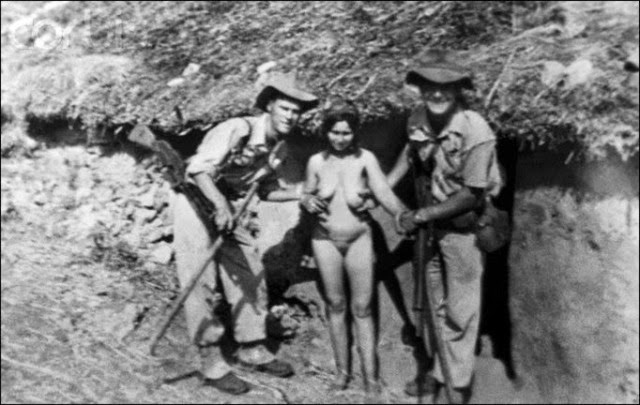
This photo is from the Algerian War, 1954 to 1962. I do not know by whom it was taken, or when, or where, nor do I know the names of the men, nor that of the woman, nor do I know whether she survived her encounter with the soldiers. “And then everyone did with her what he wanted — no matter, how many men there were. When the men are in a good mood, they let the girl go, if not, then they kill her” — a soldier named Ed Treratola told us this, about soldiers in a different war, in a different country, Vietnam. But change the men’s clothes and weapons, change their faces and their names, and this can be any war, at any time in history, in any place. (Men get raped, tortured, mutilated and killed, too, of course. And women can be perpetrators. It’s not primarily a question of gender, but of power.)
Be outraged when you look at this photo, be secretly fascinated, or be thrilled, but understand the principle: potential and desire meet opportunity and encouragement.
You may also want to look at my picture essay The Allure of Agony (PDF file, 18 MB) — you’ll find historical works of art there, though, not photographs.
If you want photos, here are some more.
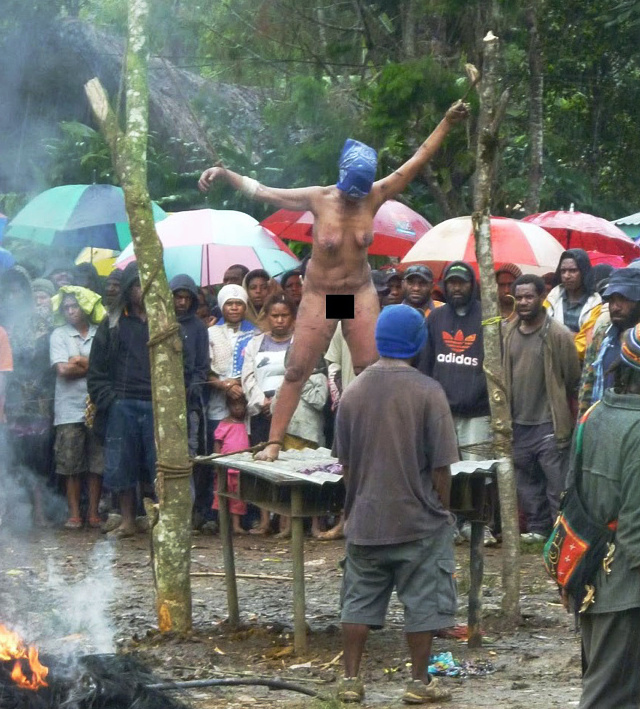
This is real, this is not from a movie. A witch is tortured in a village of Papua New Guinea, in 2013. Due to the rain that dampened the enthusiasm of the villagers and extinguished the fire, she survived, badly injured — most others in her situation did, and still do, not. The onlookers’ faces are grim — they do what is necessary to protect their village from witchcraft, and for this purpose they resolutely thwart any half-hearted attempts by the authorities to intervene.
Throughout history public executions have always drawn crowds, the more so the more elaborate and cruel they were, and they have always appealed to both (or all) genders. There are female spectators here, too, but as other photos of this scene clearly show, the front view places are all taken by men.
*
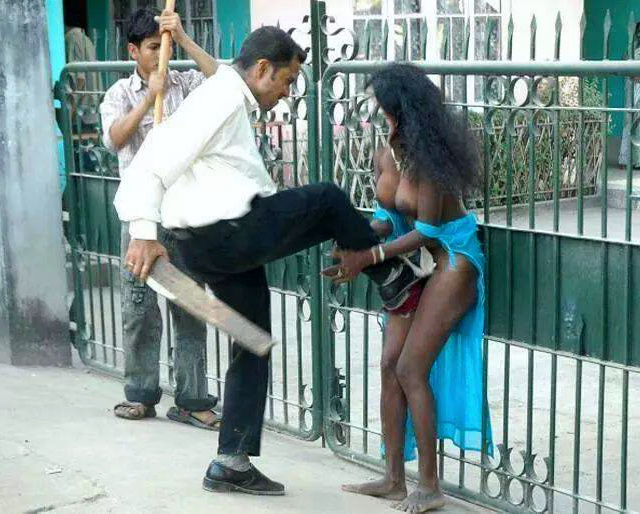
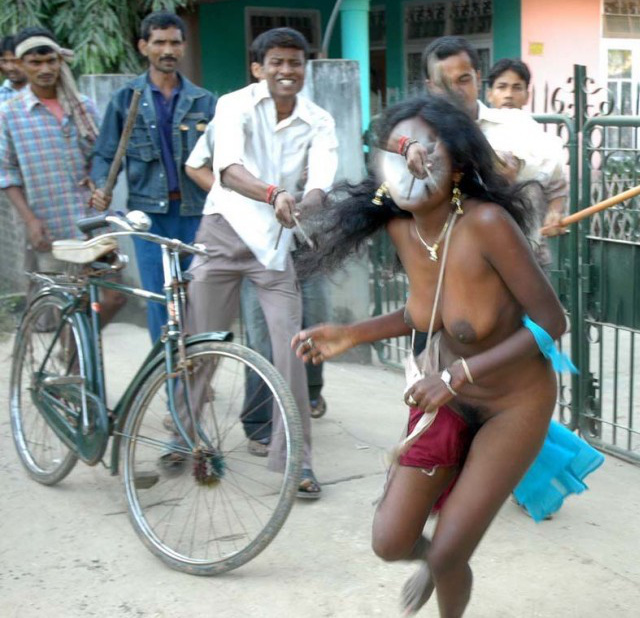
On 24th November 2007 the “All Adivasi Students’ Association Assam” staged a demonstration for the rights of ethnic minorities in the Assam metropolis of Guwahati. They were not welcome. The photos show L. O., 17 at that time. Neither passersby nor police did intervene when she was stripped, kicked, beaten and chased through the streets at the center of Guwahati. None of those who stripped, kicked, beat and chased her, none of those who watched, who laughed at her and took photos and videos, had expected this to happen when they had gotten up in the morning. But when the opportunity offered itself, wouldn’t it have been a shame to let it go to waste? To not have looked, to not have run along, to not have taken all those photographs?
“People were laughing when these boys chased and beat me around the streets of Guwahati. I was naked and begging for help, but no one came to my rescue,” she later told in an interview. “Seeing me running around naked, a man took off his shirt and gamcha and gave it to me. He asked me to flee. The boys fought with him and asked him why he was helping me? They assaulted him as well. Meanwhile, I managed to flee the place.” So, yes, there was one who intervened. It can be done, though it can come at a price.
Opportunity, and impunity — none of the perpetrators feared legal consequences, and none of them had to suffer any. L. O. was not defeated, though — she took years to recover, but has become a proud political activist for women’s and Adivasi minority rights.
*
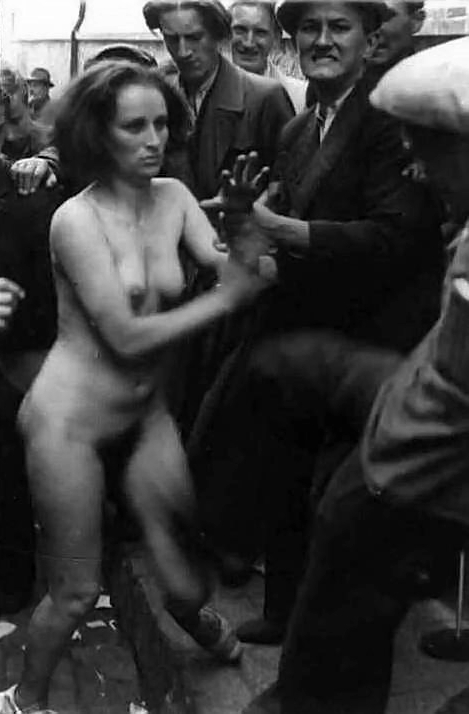
The pogrom in Lviv in 1941 was organized by the German occupiers, and carried out by the local population (the numbers are disputed, but several thousand were killed). The Germans had “propaganda troops” in place to document the pogrom, wanting photos and films that show people spontaneously rising up in a just rebellion against “the Jews,” but had to realize that the material they got wasn’t suitable for their propaganda purposes. The perpetrators, once let loose, but also the photographers, pursued their own agendas, and the photos show what those were.
And when you do an Internet image search today, you will find this photo (and others of its kind) on porn sites — “Nude Jewish Women Holocaust / Free Hot Nude Porn Pic Gallery,” “World War 2 Females Naked / Free Download Nude Photo Gallery” or “World war 2 porn Album — Top adult videos and photos.” The Nazis’ genocidal reign of terror has ended with their military defeat, but the erotic appeal of their genocide images has survived.
*

Staff of the Auschwitz concentration camp enjoying a holiday at the nearby Solahütte resort, on July 22, 1944.
More than one million people were murdered at Auschwitz. The photo is from a photo album that belonged to Karl Höcker. In 1943 Höcker had been adjutant to the commandant at the Majdanek extermination camp, and in 1944 was transferred to Auschwitz to become adjutant to commandant Richard Baer. Höcker took the pictures as personal keepsakes.
The men were happy to have assignments that kept them safely away from the frontline. The women were either happy to have secured comfortable and decently paid office jobs, or they were happy that they could participate in mass murder — we do not know, but “There is much to suggest that they were involved in the killing — after all, trips to the Solahütte were a popular reward for ‘good work’ in the death camp.” (www.welt.de/kultur/article1199238/Die-entspannte-Freizeit-der-Massenmoerder.html, September 20, 2007.)
There were female guards of all ranks — about 10% of the guards were female, some 200 at Auschwitz. Maria Mandl, for instance, who was executed in 1948 for having been been directly complicit in the deaths of over half a million prisoners. Auschwitz survivor Sala Feder told in her testimonial at Mandl’s trial, “During these selections, defendant Mandl tortured the prisoners in a cruel way, beating the women, the men and the children with a whip and kicking them blindly. She would tear the children from the arms of their mothers, and when the mothers tried to come near the children and defend them, Mandl would beat the mothers horribly and kick them. (…) Mandl selected several thousand women, and all of them — naked — were crammed into one block no. 25, where they stayed for seven days and nights without food or water. On the night of 27 September [1943], they were transported to the crematorium. For the period of these seven days, we heard horrible screams and groans issuing from that block, and when the women were taken to the crematorium, the block elder, a Slovakian woman named Cyla told us that after those seven days there were more corpses than living people in that block, and that almost all of them had bitten fingers and breasts and plucked out eyes. During these seven days, if any prisoner wanted to carry water or some food to that block, she was arrested there and perished along with the rest. The above-described selection was carried by the defendant Mandl in person, with the help from kapos: Stenia, Leo and Maria, all of them cruel and used to torturing the prisoners in a horrible manner.”
Or Margot Drechsel, or Irma Grese, or Therese Brandl, all who assisted Dr. Mengele, selecting women to be sent to their deaths. (“Selections happened the following way: First, naked women scuffled in front of Mengele with arms raised; and then in front of Greze and Drechsler. Mengele did the first selections, while the women might select also people who Mengele left unselected.”) “Grese would intentionally choose the most beautiful women first when it came to selecting victims for the gas chambers,” told Auschwitz survivor Olga Lengyel. “She beat and tortured the prisoners and tormented many of them to death. Once, I saw that a young political prisoner, Jasia from Kraków, who was one second late to the roll call, was beaten and kicked to death by Brandl. There were dozens of incidents of this kind.” (Sala Feder). “Grese would often hit women on the breasts, something she especially enjoyed doing, as well as forcing young Jewish inmates to act as lookouts while she raped other prisoners” (Wendy Adele-Marie Sarti, Women and Nazis). Auschwitz survivor Dr. Gisella Perl said about Irma Grese, “She was one of the most beautiful women I have ever seen. Her body was perfect in every line, her face clear and angelic and her blue eyes the gayest, the most innocent eyes one can imagine. And yet, Irma Grese was the most depraved, cruel, imaginative sexual pervert I ever came across.”
But maybe the merrily laughing girls on Karl Höcker’s photo were not involved in any of this, other than helping to make the genocide machine run smoothly, maybe they were just office workers, being rewarded for their good typing, their good looks, and their forthcoming personalities? The merrily laughing men in their SS uniforms hardly, though.
Sorry, this last part of the essay turned out longer than I had intended it to be. Still, it’s all about potential, desire, and opportunity. Without the Holocaust, Maria Mandel, Margot Dreschel, Irma Gese, and all the many many others, male and female, who participated in the genocide, would most likely have led normal lives, and never have tortured or killed anybody. They might not even have been fully aware of their potential and desire to do so. They did not torture and kill their victims because they hated them so much, they did it because these were the ones they were allowed and encouraged to torture and kill.
There is an ongoing discussion whether the driving force behind rapes (and accompanying tortures, mutilations and killings) in the context of war and genocide is primarily sexual or strategic. Are rapes, tortures, killings and lootings the acts of human nature released from the restrictions of civilization, or are they the acts of civilization at its worst, a part of the “art” of war?
The question is moot. They can be either, and they can be both. While mass rapes can be and have been a premeditated political or military strategy aimed at terrorizing the enemy/victim population, the perpetrators, whether they are members of regular armed forces, or whether in civil war or genocide everyone is invited to join in, always know how to combine purpose and pleasure.
It appears that like looting, rape is also a by-product of war — men who would not normally enter shops and private homes to take souvenirs and ship them home find themselves doing so — women almost seem to be seen as an extension of this, further objectified and not seen as human beings with rights but as property there for the taking. (“The Shame of War”, see below.)
When the violence began, the violence directed at the women, not surprisingly, was sexual violence. It was directed at their sexuality. And women were raped, gang-raped. They were held in sexual slavery, both forced marriages, individual sexual slavery. They were raped with objects such as sharp sticks or weapons. These rapes were followed by sexual mutilations such as cutting off of breasts or mutilations of vaginas. And this happened throughout the country throughout the genocide, and it happened in an open fashion. (…) These were not rapes that occurred in secret. These were not rapes that occurred behind closed doors. They happened at checkpoints. They happened in cultivated fields. They happened near government buildings. They happened in or near hospitals. They happened where people had fled to seek sanctuary, such as churches. They happened in plain view, in open view, and often these women, after they were raped, were left — the bodies were left dead and spreadeagled in public view. (…) One perpetrator later recounted that he “did not hear many [Hutu] women protesting against Tutsis being raped (…) They agreed on this, except of course if the men did their dirty sex work near the houses.” (“Sexual Violence in the Context of the Genocide in Rwanda”, see below.)
The sexual aspects of violence, and the violent aspects of sexuality, cannot possibly be disentangled.
Each war in itself is an act of rape.
Each individual or collective rape is an act of war.
War is rape.
Rape is war.
Violence beckons.
Loot beckons.
It doesn't help to pretend that they don’t. Only if we acknowledge our susceptibility to their appeal — “our” meaning mankind’s, but also our own — can we hope to reign it in.
Some literature on the topic:
“I Don’t Know if They Realized I was A Person.” Rape And Other Sexual Violence in the Conflict in Tigray, Ethiopia. Amnesty International, 2021.
Forensic Evidence of Torture: Investigations into Human Rights Violations. Marika Linnéa Henneberg, thesis submitted to the Faculty of Arts of The University of Birmingham, Department of Ancient History and Archaeology, School of Historical Studies, September 1999.
Rape as a Weapon of War and its Long-term Effects on Victims and Society. Cassandra Clifford, Stop Modern Slavery, Washington, DC and The Foreign Policy Association, New York, NY. 7th Global Conference Violence and the Contexts of Hostility, May 2008, Budapest, Hungary.
Sexual Violence in the Context of the Genocide in Rwanda. Verena Muckermann, Ruhr-Universität Bochum, 2021.
The Continuum of Sexual Violence in Occupied Germany, 1945–49. Hsu-Ming Teo, Women’s History Review, 5:2, 191–218, 1996.
The Shame of War. Sexual Violence Against Women and Girls in Conflict. A United Nations OCHA/IRIN publication, 2007.
“They raped us in every possible way, in ways you can’t imagine.” Gendered Crimes during the Lebanese Civil Wars. LAW – Legal Action Worldwide, December 2021.
“We Are Going to Rape You and Taste Tutsi Women.” Rape during the 1994 Rwandan Genocide. Christopher W. Mullins, British Journal of Criminology, November 2009.
Or just follow the news.
When much time had been consumed, and great numbers had fallen on both sides, nor had the Persians lost fewer than their adversaries, Amasis, the leader of the land-army, perceiving that, although the Barcaeans would never be conquered by force, they might be overcome by fraud, contrived as follows. One night he dug a wide trench, and laid light planks of wood across the opening, after which he brought mould and placed it upon the planks, taking care to make the place level with the surrounding ground. At dawn of day he summoned the Barcaeans to a parley: and they gladly hearkening, the terms were at length agreed upon. Oaths were interchanged upon the ground over the hidden trench, and the agreement ran thus: “So long as the ground beneath our feet stands firm, the oath shall abide unchanged; the people of Barca agree to pay a fair sum to the king, and the Persians promise to cause no further trouble to the people of Barca.” After the oath, the Barcaeans, relying upon its terms, threw open all their gates, went out themselves beyond the walls, and allowed as many of the enemy as chose to enter. Then the Persians broke down their secret bridge, and rushed at speed into the town — their reason for breaking the bridge being that so they might observe what they had sworn; for they had promised the Barcaeans that the oath should continue “so long as the ground whereon they stood was firm.” When, therefore, the bridge was once broken down, the oath ceased to hold.
Such of the Barcaeans as were most guilty the Persians gave up to Pheretima, who nailed them to crosses all round the walls of the city. She also cut off the breasts of their wives, and fastened them likewise about the walls. The remainder of the people she gave as booty to the Persians, except only (…) those who had taken no part in the murder, to whom she handed over the possession of the town.
The History of Herodotus, Book 4. Pheretima, with the help of her Persian allies, revenged the murder of her son, Arcesilaus III of Cyrene. The events described here took place ca. 515 BCE.
The following events took place not far away, some two and a half millennia later.
These are screenshots from a subtitled Arabic language video that I saw on YouTube, but which later was deleted. It was an interview, not an interrogation. The interviewer, who was female, spoke calmly, asked her interview partner if he felt all right, and told him that he was free to abort the interview if it made him uncomfortable. He said he was ok and didn’t mind talking. I regret that I didn’t copy more of the interview before it disappeared.
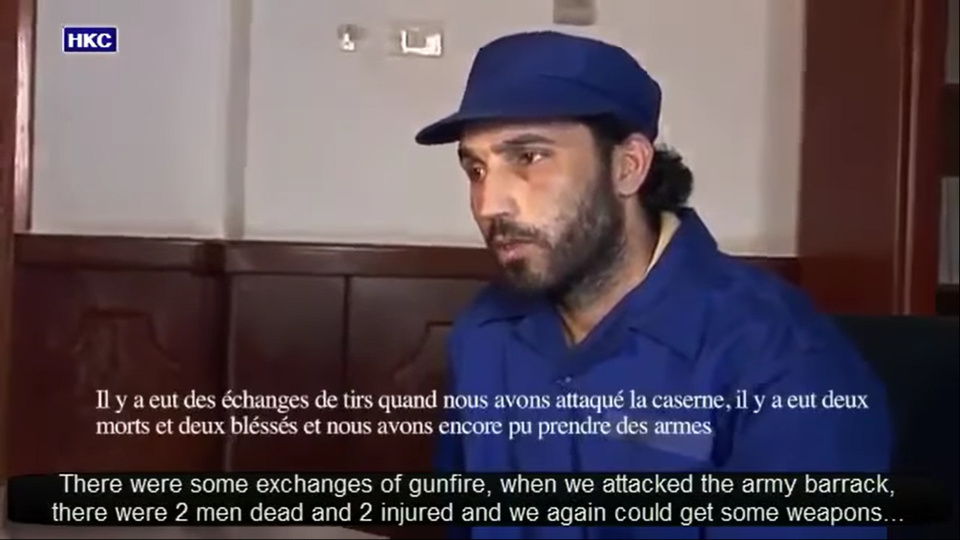
There were some exchanges of gunfire, and when we attacked the army barrack, there were 2 men dead and 2 injured and we again could get some weapons.
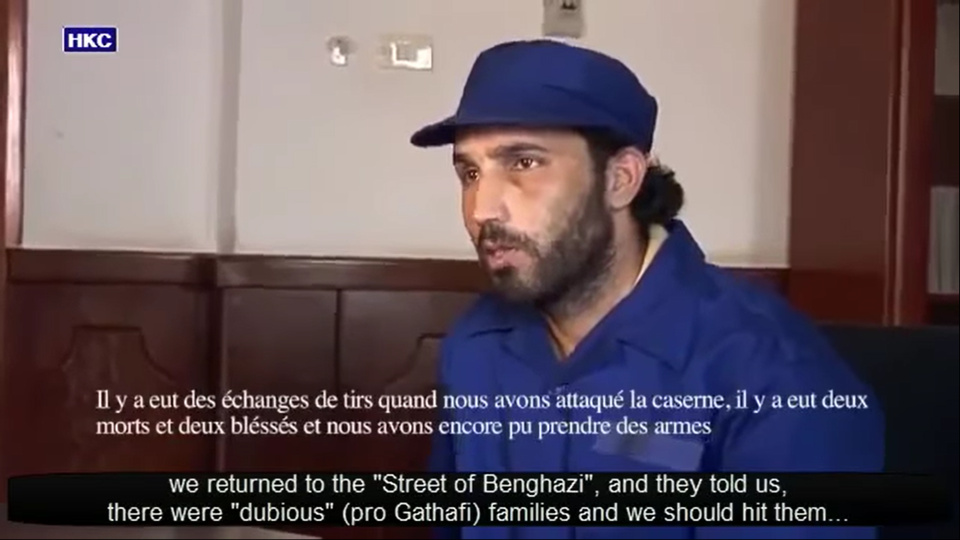
We returned to the “Street of Benghazi”, and they told us, there were “dubious” (pro Gaddafi) families and we should hit them …
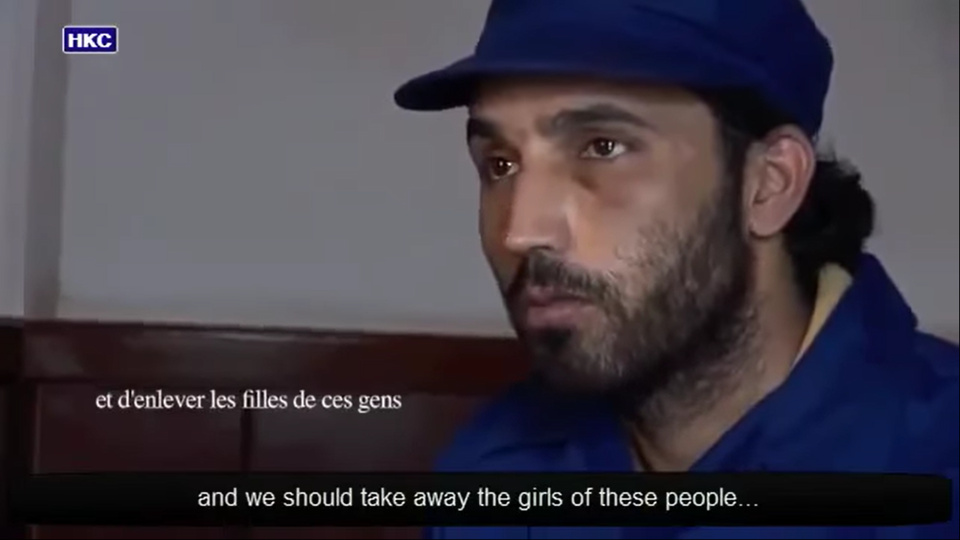
… and we should take away the girls of these people.
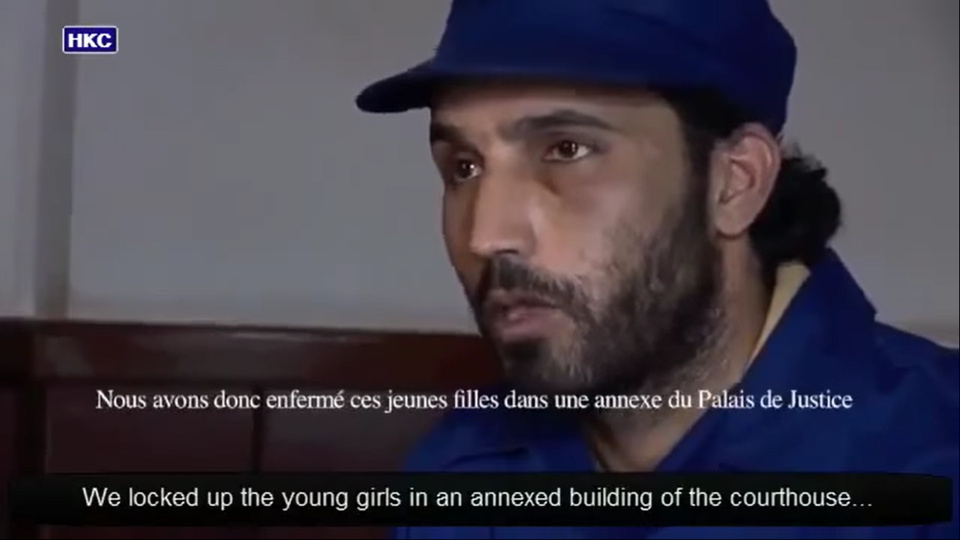
We locked up the young girls in an annexed building of the courthouse.
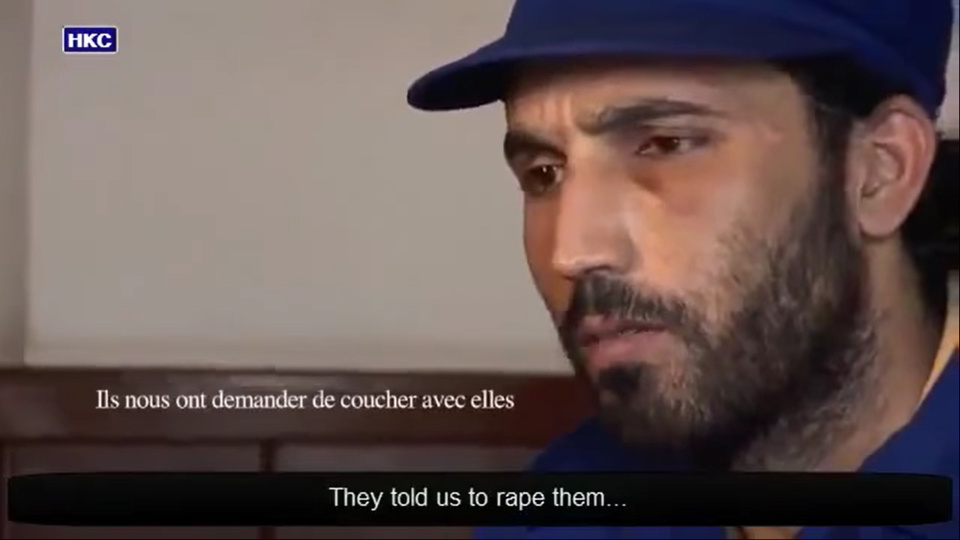
They told us to rape them.
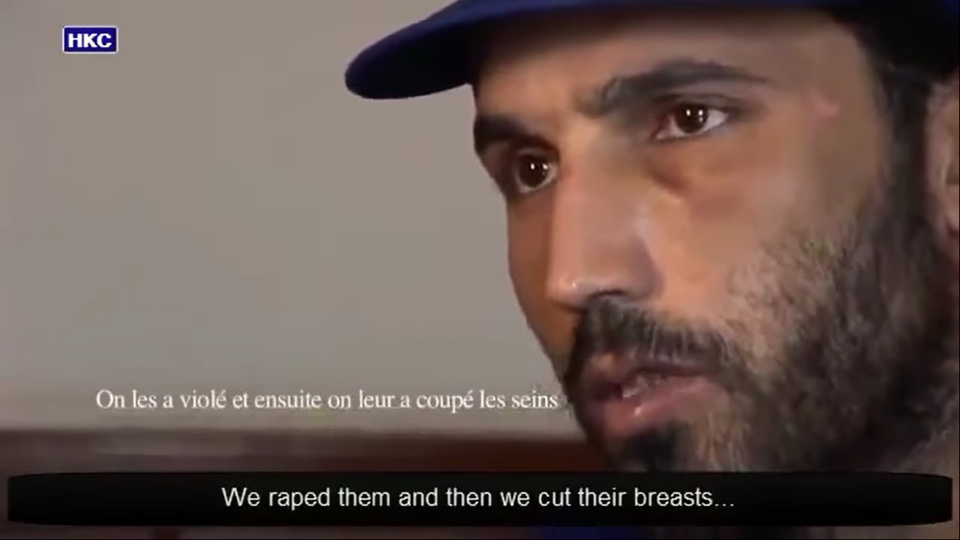
We raped them and then we cut their breasts …
I had meant the last picture to be the end of this essay, leaving you to your own feelings and your own thoughts.
But there is one request that I have: that you ask yourself under which circumstances you might commit any of those acts of violence, or participate in them, or encourage them, or watch them, or wish for them to happen, or appreciate them, or condone them, or excuse them, or look away, or deny them, or profit from them, or shrug them off. Or secretly think they deserved it, or serves them right, or it was their own fault.
And should you say “under no circumstances ever,” then ask yourself, if this is really true.
And now I leave you to your own feelings and your own thoughts.
(10/2023)